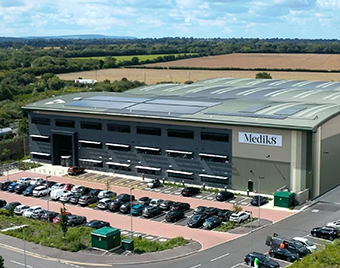Choosing the Right Pallet Racking System
Workplace design and flexible spaces have become more crucial than ever in catering to the evolving work styles and needs of employees.
Read More
03.11.2023
Are you looking to improve your current workspace or create a new one that fosters productivity and enhances employee satisfaction? The office design and build process is a crucial step towards achieving a conducive working environment that brings numerous benefits to businesses.
A well-designed workspace holds immense importance in creating a productive working environment; it should not just be about aesthetics but also about functionality and employee well-being. By carefully creating a step by step plan of the layout, lighting and ergonomics, businesses can significantly build team morale, and enhance collaboration and overall productivity within their office.
One of the key benefits of a well-designed workspace is the positive impact it can have on the businesses – research has consistently shown that a thoughtful office design can lead to increased employee satisfaction, lower stress levels, and improved focus.
With an environment that fosters creativity and efficiency, companies can expect heightened employee engagement, reduced turnover, and ultimately, better business performance.
The office design and build process of a new office space involves a comprehensive overview of various stages delivered by our project managers. From initial space planning and conceptualisation to material sourcing, construction and final finishing touches, each step of a workplace design plays a vital role in creating a workspace that optimises functionality and promotes comfort. A well-executed process ensures that the office design aligns with the specific needs, brand identity, and goals of the business.
Collaborating with experienced content strategists is an essential aspect of the office design and build process. These professionals understand the ins and outs of creating a workspace that not only meets the business requirements but also amplifies brand messaging and culture. By working closely with strategists, companies can ensure that their office design effectively communicates their values and objectives to both employees and clients. Continue reading this article to learn more about office design and build processes, and how to optimise your new office space or workplace.
When it comes to creating a new workspace, understanding the fundamentals of functional and efficient office spaces is crucial. This involves carefully planning and considering the layout, flow, and organisation of the office in order to maximise productivity and collaboration among employees.
Incorporating branding and company culture into the design is a seemingly minor detail that can actually prove essential, as the office space should reflect the identity and values of the business, helping to create a sense of unity and pride among employees.
The impact of aesthetics on employee productivity and well-being cannot be overlooked.
A well-designed office space can inspire creativity, boost morale, and improve employee satisfaction, making it important to consider factors such as lighting, color schemes, and furniture choices that contribute to creating an appealing and comfortable office environment that employees will find inspiring and be able to work from with maximum efficiency and effectiveness.
By incorporating design elements that align with the company’s identity and values, the office space can become a visually stimulating and inspiring place for employees to work.
Creating a workspace that fosters collaboration and effective communication is essential for any successful expert design. By designing and creating spaces that promote teamwork and interaction, companies can improve employee engagement and productivity. Some ways to do this could include:
Employee well-being should be at the forefront of any office design project. By prioritising ergonomics and health considerations, companies can create a workspace that not only enhances productivity but also improves employee satisfaction and retention.
Optimising office space is crucial for maximising productivity and efficiency – by strategically planning and utilising space, businesses can ensure that their workspace meets the specific needs of employees and the organisation.
When it comes to implementing the office design, choosing the right furniture and office equipment is crucial. The selection process involves several considerations to ensure a functional and aesthetically pleasing workspace.
In addition to these considerations, it is important to look for ergonomic options and sustainability features in office furniture and equipment; as ergonomics plays a vital role in creating a healthy and comfortable work environment.
Proper lighting and acoustics are essential for creating a productive workspace and helping employees reach their full potential. Good lighting improves visibility and reduces eye strain that poor lighting induces, while proper acoustics minimise distractions and promote focus.
Soundproofing solutions are also important to create a quiet and comfortable workspace. Consider the following:
Integrating sustainability and eco-friendly practices in the office design is becoming increasingly important, and making conscious choices can significantly reduce the environmental impact of the workspace.
By incorporating sustainable materials and practices in the office design, companies can contribute to a greener future while creating a modern and eco-friendly workspace.
When it comes to office design, there are several technical aspects that need to be taken into consideration in order to create a functional and efficient workspace.
Implementing smart technologies for increased efficiency and connectivity:
Creating a seamless and technologically advanced office environment:
Understanding regulations and legal requirements for office spaces:
Ensuring compliance with building codes and accessibility standards:
Creating a new workspace involves a comprehensive office design and build process to ensure a successful outcome. This process encompasses various stages, including project management, contractor selection and coordination, as well as employee involvement and feedback.
Step-by-step guide to managing the office design and build process:
Creating a realistic timeline for the completion of the project:
Factors to consider when selecting contractors for the project:
Effective coordination with contractors to ensure a smooth process:
Strategies for involving employees in the design process:
Gathering feedback and incorporating employee preferences:
By following a well-defined office design and build process, businesses can create a workspace that meets their needs and enhances productivity.
Relocating to a new building or redesigning your office is a significant milestone for your business, presenting an opportunity for growth, a fresh start, and improved productivity. However, managing change and transitioning to a new workspace can be a complex process.
To ensure a successful transition, it is crucial to implement effective change management strategies:
Change in the work environment can be unsettling for employees, and office relocation is no exception, making it essential to communicate the reasons for the move, address any concerns, and involve employees in the process. By involving your employees from the early stages of planning, you can foster a sense of inclusion and make them active participants in the transition, ensuring they feel valued and informed.
Another aspect of managing change is providing clear guidance and support to your employees during the relocation. This includes providing regular updates, addressing any questions or concerns promptly, and ensuring that employees have the necessary resources to adjust to the new workspace.
To ensure a smooth transition, it is crucial to develop a comprehensive transition plan. This plan should include clear timelines, tasks, and responsibilities for all stakeholders involved. By setting clear expectations and providing support, you can minimise disruptions and ensure productivity during the transition period.
Encourage collaboration and provide opportunities for employees to provide feedback and suggestions during the transition process.
When embarking on an office build project, one of the crucial aspects to consider is budgeting and cost management. Proper planning and financial management are essential to ensure that the project stays on track and meets its financial objectives.
Before diving into your office design and build process, it is important to have a clear understanding of the budget that you will be allocating to the project. This involves conducting a thorough analysis of the desired outcomes, scope, and resources needed for the project, as well as the time frame that you would need it done in.
During the estimation phase, various other factors need to be considered, such as the size of the workspace, the complexity of the design, and any specific requirements or preferences; this information helps in determining the amount of financial resources that need to be allocated to different aspects of the project.
Once the budget has been estimated, it is crucial to allocate the funds effectively, which will involve breaking down the budget into different categories, such as construction, materials, furniture, technology, and contingency. Allocating the budget in this manner ensures that each aspect of the project receives adequate funding for successful implementation.
The office design and build process plays a crucial role in creating a new workspace that is both functional and aesthetically pleasing. By considering key factors such as space planning, ergonomics, and technology integration, businesses can ensure that their office environment supports productivity and enhances employee satisfaction.
Utilising the experts at SEC Interiors can provide immense benefits in creating a new workspace; our expertise and knowledge can help your business make informed decisions and navigate through the complexities of the design and build process. We can offer insights into industry trends, space optimisation techniques, and innovative design solutions that will be fully customised to your building, business and team culture, so as to help you get the most out of your new workplace design.
The impact of a well-designed office environment on employee satisfaction and productivity cannot be overstated. A thoughtfully designed workspace can enhance employee morale, engagement, and overall job satisfaction, also helping to create a positive impression on clients and visitors, conveying professionalism and attention to detail.
By investing in a comprehensive office design and build process collaborating with SEC’s experienced content strategists and design experts, your business can create a workspace that not only meets your functional requirements but also fosters creativity, collaboration, and productivity.

Workplace design and flexible spaces have become more crucial than ever in catering to the evolving work styles and needs of employees.
Read MoreHarry Watts of SEC Storage outlines how to achieve strategic alignment in your warehouse, by adopting SEC’s ‘SAVES Cost’ approach.
Read More
In the world of cosmetics, innovation and sustainability are the driving forces that push boundaries and set new standards. In this case study, we delve into a unique project and partnership that exemplifies these principles. Our collaboration with Medik8, a prominent cosmetics company known for its commitment to sustainability, brought together logistics, manufacturing, research and development (R&D), and the supply chain into a cohesive operation. This case study highlights the challenges faced, meticulous planning, effective communication, and the transformative journey that turned discussions into decisive actions.
Watch Video